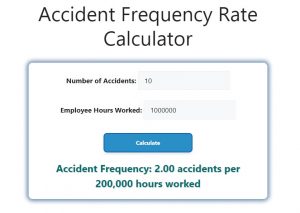About Accident Frequency Rate Calculator (Formula)
Accident frequency rate (AFR) is a critical metric in occupational health and safety management. It helps organizations assess their safety performance by calculating the number of workplace accidents relative to the hours worked by employees. Understanding and calculating the accident frequency rate is vital for identifying trends, evaluating safety practices, and ensuring a safer work environment. This article will guide you through the formula, how to use it, and provide examples and FAQs to enhance your understanding of accident frequency rates.
Formula
The formula for calculating the Accident Frequency Rate is:
Accident Frequency = (Number of Accidents * 200,000) / Employee Hours Worked
Where:
- Number of Accidents refers to the total workplace accidents recorded in a specific period.
- Employee Hours Worked represents the total number of hours worked by all employees during the same period.
How to Use
- Gather Data: Collect data on the total number of workplace accidents and the total employee hours worked during a specific time frame, usually a year.
- Apply the Formula: Substitute the values into the formula to calculate the accident frequency rate.
- Interpret Results: A lower AFR indicates a safer workplace, while a higher AFR signifies potential safety concerns that may need addressing.
Example
Let’s say a company had 10 accidents in a year, and its employees worked a total of 1,000,000 hours. To calculate the accident frequency rate:
- Number of Accidents = 10
- Employee Hours Worked = 1,000,000
- Accident Frequency = (10 * 200,000) / 1,000,000
- Accident Frequency = 2
In this case, the accident frequency rate is 2, meaning there were 2 accidents per 200,000 hours worked.

FAQs
- What is Accident Frequency Rate (AFR)?
AFR is a measure of workplace safety that indicates how often accidents occur relative to the total hours worked. - Why is calculating AFR important?
It helps organizations identify safety issues, assess performance, and implement improvements. - How often should I calculate AFR?
It’s advisable to calculate AFR regularly, typically annually or quarterly, to monitor trends. - What does a high AFR indicate?
A high AFR suggests a higher frequency of accidents and potential safety concerns within the workplace. - Can AFR be compared across different industries?
While AFR can be compared, safety standards vary by industry, making direct comparisons less meaningful. - What is considered a good AFR?
A good AFR varies by industry, but generally, lower values are better, indicating fewer accidents. - How can I reduce my organization’s AFR?
Implementing comprehensive safety training, regular audits, and addressing identified hazards can help reduce AFR. - What types of accidents are included in the calculation?
All workplace-related injuries and accidents should be included in the count, regardless of severity. - Is there a standard method for reporting accidents?
Yes, organizations should establish a standardized procedure for reporting and documenting workplace accidents. - What are some common causes of workplace accidents?
Common causes include lack of training, inadequate safety equipment, unsafe working conditions, and human error. - Can external factors influence AFR?
Yes, external factors like changes in regulations or economic conditions can impact accident rates. - How can technology assist in reducing accidents?
Utilizing safety management software and wearables can help monitor risks and improve safety compliance. - What role do employees play in improving AFR?
Employees should be actively involved in safety training, reporting hazards, and participating in safety committees. - How does employee morale affect workplace safety?
Higher employee morale often correlates with improved safety practices and lower accident rates. - What are the consequences of high accident frequency?
High accident frequency can lead to increased insurance costs, legal liabilities, and a negative company reputation. - Can AFR be used for performance evaluations?
Yes, organizations can use AFR as a performance metric for evaluating safety management effectiveness. - What are some best practices for maintaining a low AFR?
Best practices include regular safety training, conducting risk assessments, and fostering a safety-first culture. - How can I communicate safety policies effectively?
Clear communication through training sessions, safety meetings, and visible signage can enhance understanding of safety policies. - What is the relationship between training and AFR?
Proper training equips employees with the knowledge and skills needed to prevent accidents, thus lowering AFR. - How do regulatory agencies view AFR?
Regulatory agencies often monitor AFR as part of compliance requirements and to promote workplace safety standards.
Conclusion
The Accident Frequency Rate Calculator is an essential tool for organizations aiming to improve workplace safety and assess their performance in managing occupational hazards. By calculating AFR, companies can identify areas for improvement, implement necessary changes, and foster a safer work environment. Regularly monitoring and analyzing this metric not only helps in compliance with safety regulations but also contributes to overall employee well-being and productivity.
